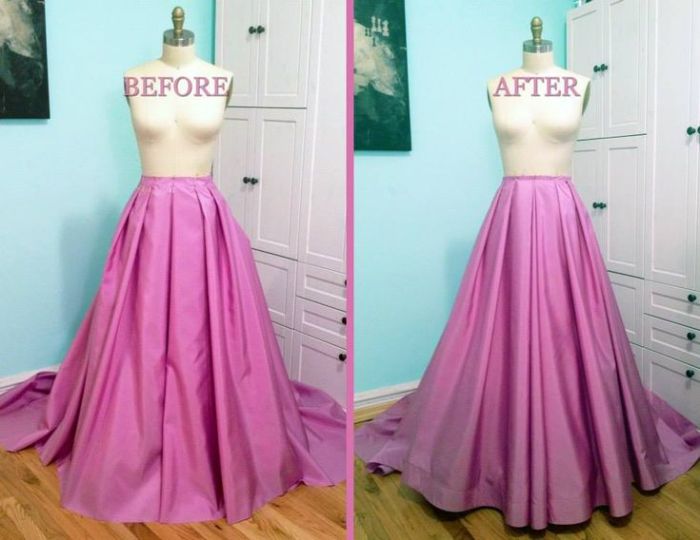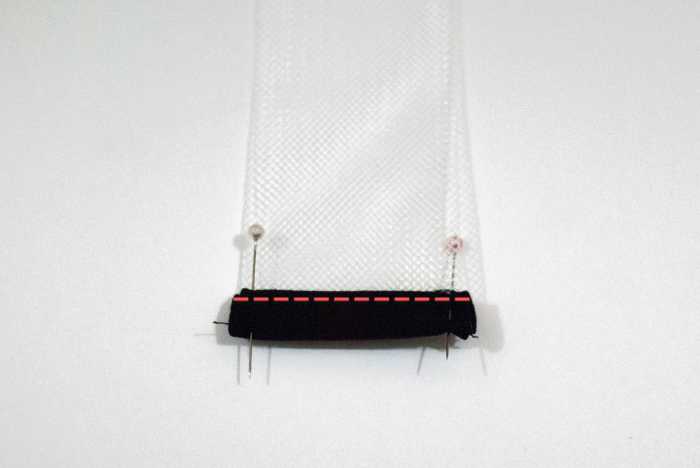Horsehair Hem Wedding Dress A Timeless Elegance
A History of Horsehair Hems in Wedding Dresses
Horsehair hem wedding dress – The horsehair hem, a subtle yet significant detail in bridal fashion, boasts a rich history intertwined with evolving social norms and technological advancements. This elegant finishing technique, lending structure and a graceful drape to wedding gowns, offers a fascinating glimpse into the craftsmanship and aesthetic preferences of different eras.
Historical Evolution of Horsehair Hems
The use of horsehair in dressmaking dates back centuries, initially employed for its strength and ability to hold a shape. While precise origins are difficult to pinpoint, its adoption in bridal wear likely coincided with the increasing popularity of elaborate gowns in the Victorian era (1837-1901). The stiffening properties of horsehair provided the necessary support for the voluminous skirts and intricate details characteristic of the time.
Its use continued through the Edwardian era (1901-1910) and into the early 20th century, though its prominence fluctuated with changing fashion trends.
Social and Cultural Significance of Horsehair Hems
The presence of a horsehair hem often signaled a bride’s social standing and the family’s financial resources. The high-quality horsehair and skilled labor required to create these hems made them a luxury, accessible primarily to the upper echelons of society. In contrast, simpler hems were used for less formal or more modestly priced gowns. The cultural significance shifted over time; while initially a symbol of wealth, horsehair hems later became associated with classic elegance and enduring quality.
Comparison with Other Hem Finishing Techniques
Throughout history, various techniques have been employed to finish the hems of wedding dresses. Horsehair offered a unique combination of structure, weight, and subtle sheen, distinguishing it from simpler methods like rolled hems or machine-stitched finishes. While other materials like buckram or stiffening interfacings could provide support, horsehair’s flexibility and subtle texture provided a more elegant and less rigid result.
The choice of hem finish often reflected the desired aesthetic – a crisp, structured hem versus a softer, more fluid drape.
The Craft of Creating a Horsehair Hem
Constructing a horsehair hem is a specialized skill, requiring precision and attention to detail. Understanding the materials and techniques involved allows for appreciation of the craftsmanship behind this elegant finishing touch.
Horsehair hem wedding dresses offer a delightful combination of classic elegance and subtle drama, the stiff hemline creating a beautiful sway with every movement. For a whimsical, enchanting alternative, consider the ethereal beauty of a green fairy wedding dress , though the horsehair hem remains a timeless choice for brides seeking a touch of refined sophistication in their bridal attire.
Ultimately, the horsehair hem adds a unique textural element that elevates the overall design.
Creating a Horsehair Hem: A Step-by-Step Guide
The process typically involves attaching a horsehair braid to the raw edge of the fabric. First, the hemline is carefully prepared and pressed. Then, a horsehair braid, selected for its weight and stiffness, is carefully basted to the inside of the hem allowance. Finally, the hem is stitched down, concealing the braid and creating a clean, finished edge. The precise stitching method varies depending on the gown’s fabric and the desired finish.
Influence of Braid Width and Density

Source: pinimg.com
The width and density of the horsehair braid significantly influence the drape and structure of the hem. A wider, denser braid creates a more substantial, stiffer hem, suitable for structured gowns. Conversely, a narrower, less dense braid produces a softer, more fluid drape, appropriate for flowing silhouettes. Experimentation and careful selection are crucial for achieving the desired aesthetic.
Types of Horsehair Braid
| Braid Type | Material Composition | Weight | Drape |
|---|---|---|---|
| Standard Horsehair Braid | 100% Horsehair | Medium-Heavy | Structured, slight stiffness |
| Silk-Wrapped Horsehair Braid | Horsehair with Silk Covering | Medium | More flexible, subtle sheen |
| Synthetic Horsehair Braid | Polyester or Nylon | Light-Medium | Soft, less structured |
| Cotton-Covered Horsehair Braid | Horsehair with Cotton Covering | Medium-Light | Soft, subtle texture |
Aesthetic Considerations and Design Choices
The horsehair hem’s visual impact is dramatically affected by its interaction with the wedding dress silhouette and fabric. Careful consideration of these elements is key to achieving a harmonious and elegant result.
Horsehair Hems and Wedding Dress Silhouettes
A horsehair hem can dramatically alter the perception of a gown’s silhouette. On A-line gowns, it enhances the natural flare, providing a crisp, defined edge. In ball gowns, it adds structure and support to the voluminous skirt, preventing sagging. On sheath or mermaid silhouettes, a horsehair hem can add a subtle weight and movement, creating a more dramatic sweep.
Modern Design Incorporations
Contemporary designers often utilize horsehair hems in innovative ways, incorporating them into modern silhouettes and unconventional fabrics. They may use it to accentuate specific details, such as a train or a tiered skirt, or to create subtle textural contrasts.
Texture and Sheen Interactions, Horsehair hem wedding dress
The subtle sheen and texture of horsehair can beautifully complement various fabrics. It works particularly well with heavier fabrics like silk taffeta or satin, adding structure without overpowering the drape. With lighter fabrics like chiffon or tulle, it provides subtle weight and movement, preventing excessive flow.
Wedding Dress Sketch Examples
Sketch 1: A classic A-line gown in ivory silk taffeta, featuring a wide horsehair hem that flares dramatically, creating a defined, structured silhouette. The horsehair subtly adds weight and movement to the skirt.
Sketch 2: A modern sheath gown in crepe, with a narrow horsehair hem that creates a delicate, fluid movement. The subtle weight of the horsehair adds a touch of elegance without overwhelming the sleek silhouette.
Sketch 3: A bohemian-inspired gown in flowing silk chiffon, with a layered skirt featuring varying widths of horsehair hems on each layer. This creates a visually interesting effect, with subtle variations in drape and movement.
Modern Interpretations and Variations
While traditional horsehair hems retain their appeal, contemporary bridal fashion explores innovative alternatives and sustainable practices.
Current Trends in Horsehair Hems
Current trends showcase a renewed appreciation for the subtle elegance of horsehair hems. Designers are experimenting with varying widths, densities, and colors of horsehair braid, creating unique and personalized effects. The use of horsehair is often combined with other textural elements to add depth and interest to the gown.
Traditional vs. Modern Alternatives
Modern alternatives, such as horsehair-like synthetic fabrics, offer a more affordable and potentially more sustainable option. However, these alternatives often lack the subtle sheen and unique texture of genuine horsehair. The choice between traditional and modern alternatives depends on the desired aesthetic, budget, and ethical considerations.
Reputable Bridal Designers
- Vera Wang
- Monique Lhuillier
- Carolina Herrera
- Oscar de la Renta
- Elie Saab
Sustainable and Ethical Considerations
Increasingly, brides are seeking sustainable and ethically sourced wedding attire. Using recycled or organically produced horsehair braid, or opting for responsible and transparent manufacturers, contributes to a more environmentally and socially conscious choice.
Care and Maintenance of Horsehair Hems

Source: thesimplelifecompany.com
Proper care and maintenance are essential for preserving the beauty and longevity of a horsehair hem. Addressing potential issues promptly can prevent significant damage.
Cleaning and Preservation
Professional dry cleaning is recommended for wedding dresses with horsehair hems. Avoid harsh chemicals or abrasive cleaning methods, which can damage the horsehair and the gown’s fabric. Proper storage in a breathable garment bag is crucial to prevent damage and maintain the hem’s shape.
Addressing Common Issues
- Inspect the hem regularly for any snags or fraying. Gently trim any loose threads with sharp scissors.
- If a snag occurs, carefully pull the loose thread back into place, avoiding pulling too hard to prevent further damage.
- For more significant damage, consult a professional seamstress specializing in bridal gown repair.
- Store the dress in a cool, dry place, away from direct sunlight and moisture.
- Avoid using harsh chemicals or strong fragrances near the dress.
Essential Questionnaire: Horsehair Hem Wedding Dress
Can I wash a horsehair hem wedding dress?
Dry cleaning is strongly recommended to preserve the horsehair hem and prevent damage. Avoid washing at home.
How much does adding a horsehair hem cost?
The cost varies greatly depending on the length, type of horsehair braid, and the seamstress’s rates. Expect to pay a premium for this specialized service.
Can I add a horsehair hem to an existing dress?
Yes, a skilled seamstress can usually add a horsehair hem to an existing wedding dress, but it’s crucial to choose a professional with experience in this type of work.
What happens if the horsehair hem gets snagged?
Carefully try to gently pull out the snag. If it’s severe, consult a seamstress for repair.



















